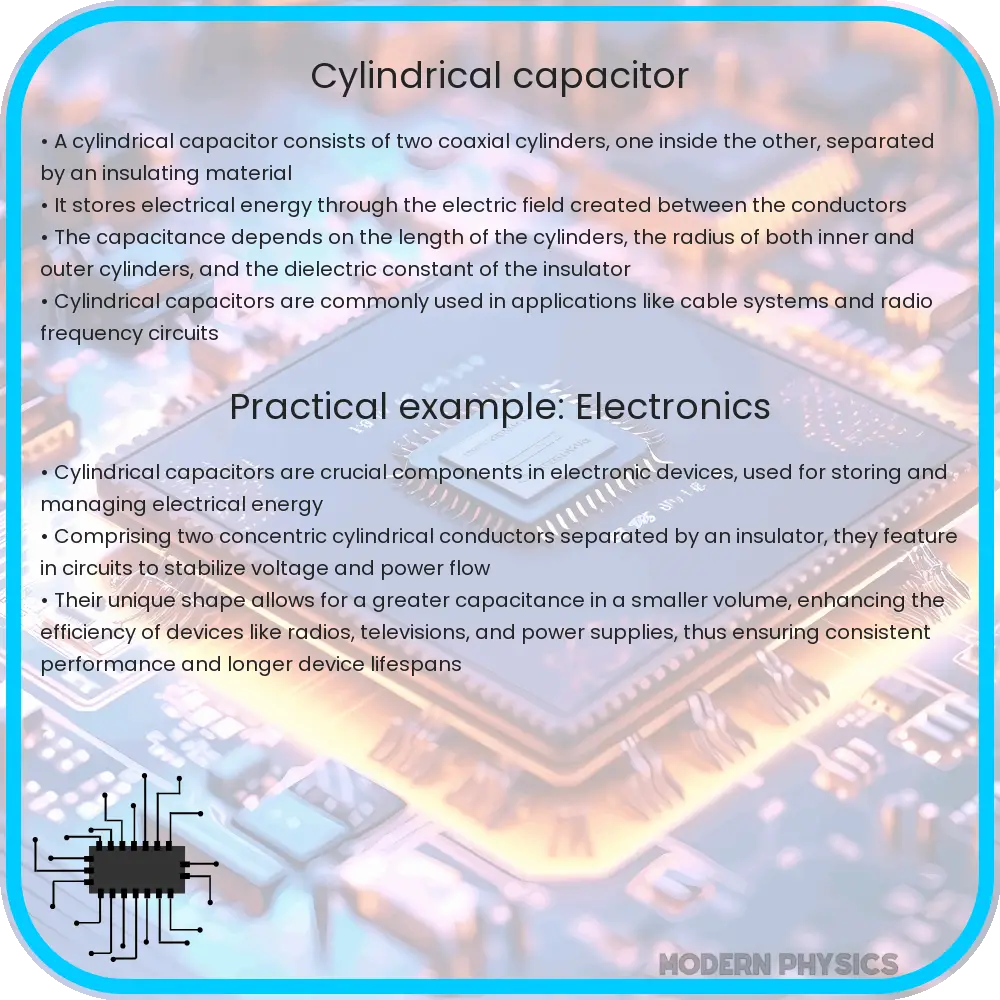Explore the theory, calculations, and applications of cylindrical capacitors, key components in modern electronics, with a focus on advancements and sustainability.

Understanding Cylindrical Capacitors
Cylindrical capacitors are a fundamental component in modern electronics, known for their unique structure and efficient energy storage capabilities. This article explores the theory behind cylindrical capacitors, their calculation methods, and diverse applications.
Theory of Cylindrical Capacitors
A cylindrical capacitor consists of two coaxial cylinders, one inside the other, separated by a dielectric material. This design allows for a uniform electric field between the cylinders, enhancing its capacitance – the ability to store an electric charge. The key principle governing a cylindrical capacitor’s operation is the electrostatic field created between the conductors.
Calculating Capacitance
The capacitance of a cylindrical capacitor is determined by its dimensions and the dielectric constant of the insulating material between the cylinders. The formula for calculating capacitance (C) is given by:
C = 2πε₀εrL / ln(b/a)
where:
- ε₀ represents the permittivity of free space (approximately 8.85 × 10-12 F/m).
- εr is the relative permittivity of the dielectric material.
- L is the length of the cylinders.
- a and b are the radii of the inner and outer cylinders, respectively.
- ln denotes the natural logarithm.
This equation highlights how the capacitance increases with the length of the cylinders and the dielectric constant but decreases with the logarithm of the ratio of the radii.
Applications of Cylindrical Capacitors
Cylindrical capacitors are extensively used in various fields due to their high capacitance and compact size. Some common applications include:
- Power Supply Filters: They smooth out the output of power supplies, reducing voltage ripples and spikes.
- Radio Frequency (RF) Circuits: They are crucial in tuning and impedance matching in RF circuits.
- Energy Storage: Used in applications requiring high capacitance and voltage ratings, such as in pulsed power systems and power conditioning.
These capacitors are also employed in medical devices, telecommunications, and automotive electronics, underlining their versatility and importance in modern technology.
Advancements in Cylindrical Capacitor Technology
The technology behind cylindrical capacitors has seen significant advancements, focusing on enhancing efficiency and reducing size. Innovations in dielectric materials have led to higher capacitance values and better temperature stability. Nanotechnology has also played a role in improving the surface area of electrodes, thereby increasing the overall capacitance without compromising the capacitor’s size.
Maintenance and Safety Considerations
Maintenance of cylindrical capacitors is crucial for ensuring their longevity and safe operation. Regular checks for leakage, dielectric breakdown, and terminal connections are necessary. It’s also essential to consider the capacitor’s voltage rating and operating temperature to prevent failures and potential hazards.
Environmental Impact and Recycling
With growing environmental concerns, the manufacturing and disposal of cylindrical capacitors are under scrutiny. Efforts are being made to use eco-friendly materials and to recycle components, reducing the ecological footprint of electronic waste. This approach not only addresses environmental concerns but also aligns with global sustainability goals.
Conclusion
Cylindrical capacitors, integral to the electronics industry, have evolved significantly from their initial designs. Their ability to store electrical energy efficiently in a compact form has made them indispensable in a myriad of applications, from simple power supplies to complex medical equipment. Advancements in materials and technology continue to enhance their performance, making them more efficient and environmentally friendly. As electronic devices become increasingly integrated into our daily lives, the role of cylindrical capacitors remains crucial, symbolizing the intersection of innovation, efficiency, and sustainability in the field of electronics.
Understanding the principles, calculations, and applications of cylindrical capacitors not only provides insights into their functionality but also highlights the continuous evolution and importance of these components in modern technology. Whether it’s in improving existing devices or innovating new solutions, cylindrical capacitors will continue to be a cornerstone in the advancement of electronic engineering.
